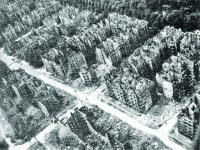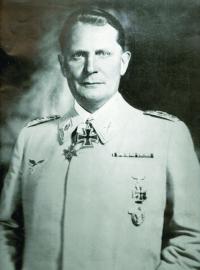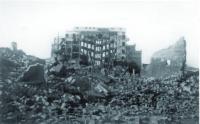
Monument to the victims of the Hamburg bombing.

Hamburg after the 1943 bombing.

Goering w/ medals Blue Max from WWI, Knight's Cross & Iron Cross.

Hamburg after the 1943 bombing.
THIS WEEK, seventy years ago, Hell came to Hamburg, Germany. It was delivered by the Allied Air Forces and was titled, "Operation Gomorrah." When it was finished 42,000 were dead - 21,000 women, 13,000 men and 8,000 children - and a million displaced.
Today, Hamburg is the second largest city in Germany and the sixth largest city in the European Union, with more than 1.8 million residents. The greater metropolitan area counts 5,000,000 inhabitants. It is located on the River Elbe and its port is the second largest in Europe and the 10th largest in the world. Its location on the Elbe gives it easy access to the North Sea and from there, the world.
By the time of Operation Gomorrah, Hamburg had already been subjected to more than 35 air raids of varying sizes, intensity and duration. But nothing prepared it for what occurred this week, seventy years ago.
On the night of July 24, 1943, 791 British bombers attacked the city. It was the first time that Allied bombers had used "Windows." "Windows" is an anti-radar measure in which small pieces of aluminum are dropped to overwhelm the radar screens. The search lights, anti-aircraft guns and night fighters were all blinded, leaving them virtually useless. Hamburg was rendered defenseless against the Allied airborne terror.
The next day, approximately 100 American B-17's attacked the submarine pens at Hamburg. The Americans repeated this attack with 71 B-17's the following day. A 700 plane nighttime attack by the British was diverted to Essen because of the smoke still lingering over Hamburg. Instead, six British Mosquitos attacked Hamburg. On the evening of July 27, another 787 British bombers - 353 Lancasters, 244 Halifaxes, 116 Stirlings and 74 Wellingtons - attacked the defenseless city using a high concentration of incendiary bombs.
Unfortunately for the city, this particular summer, seventy years ago, was exceptionally hot and dry. These factors all coalesced to create a horrific fire storm. Winds reached up to 150 miles per hour, while temperatures reached 1,500 degrees Fahrenheit. The fires climbed to a height of more than 1,000 feet. The streets burst into flames. As fuel from damaged and destroyed ships spilled into canals and harbor, it ignited. While the firestorm raged, it sucked the oxygen from the city and its bomb shelters, killing all. It swept people off the streets like dry leaves.
The next night, the city was attacked by four British Mosquitos. On the night of July 29, 777 British bombers returned to attack the stricken city. After a two-day respite, 350 British bombers returned on the evening of August 2. Although Hamburg would be hit another 54 times before war’s end, it would never suffer death and destruction such as this week, seventy years ago.
A total of 2,353 British heavy bombers dropped 7,196 high explosive and incendiary bombs with a weight of 4,300 tons. In all, the two air forces dropped about 9,000 tons of bombs, with 4,400 tons being high explosives, 2,700 tons of stick bombs, weighing 3.5 lbs. each and 1,900 tons of liquid incendiary bombs. The operation involved more than 100,000 men, including air crews, technicians and ground support. The British lost 57 plans, or 2.4 percent. The RAFÙs chief, Sir Arthur "Bomber" Harris described the losses "minute."
On the ground, half of Hamburg’s dwelling houses were completely destroyed with the remainder suffering varying degrees of damage. More homes were destroyed in Hamburg in this operation than all of the homes destroyed by the Luftwaffe, in England, during the entire war. In addition, industrial buildings, businesses, schools, hospitals, churches, banks and offices were all destroyed. 180,000 tons of shipping was sunk in the harbor. An estimated 40,000,000 tons of debris were created. From all of the air raids, 55,000 citizens of Hamburg died - almost as many casualties as the British Army suffered between the evacuation of Dunkirk, in 1940, and the Battle at Arnhem, in 1944. Almost as many Hamburg residents died from the Allied bombing, as died on the front lines - 63,000.
Operation Gomorrah eliminated the last vestiges of the Luftwaffe Chief, Reichsmarschall Hermann GöringÙs good standing among the German citizens. Once popular, he had guaranteed that "his" Luftwaffe could supply the Sixth Army at Stalingrad - and it failed - and as a consequence, their sons and brothers had died. He had guaranteed that "his" Luftwaffe would protect German homes and cities from enemy air attacks - and it failed - and as a consequence, German mothers, sisters and children were killed, maimed and left homeless.
NEXT WEEK: PLOESTI
Mr. Wimbrow writes from Ocean City, Maryland, where he practices law representing those persons accused of criminal and traffic offenses, and those persons who have suffered a personal injury through no fault of their own. Mr. Wimbrow can be contacted at
wimbrowlaw@gmail.com



